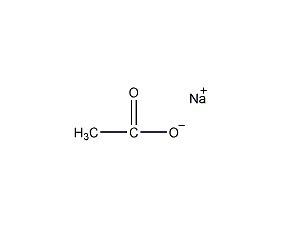
Structural formula
| Business number | 03KN |
|---|---|
| Molecular formula | C2H3NaO2 |
| Molecular weight | 82.03 |
| label |
Anhydrous sodium acetate, Anhydrous sodium acetate, Sodium acetate, Acetic acid sodium salt, auxiliary agent, buffer, Desiccant, mordant |
Numbering system
CAS number:127-09-3
MDL number:MFCD00012459
EINECS number:204-823-8
RTECS number:AJ4300010
BRN number:3595639
PubChem number:24899538
Physical property data
1. Properties: colorless transparent crystals or white particles 2. Relative density: 1.45 (trihydrate); 1.528 (Anhydrous)
3. Refractive index: 1.464
4. Melting point (℃): 324
5. Solubility: easy Soluble in water, slightly soluble in ethanol and ether.
Toxicological data
1. Skin/eye irritation: Rabbit skin standard Drez eye dye test: 500mg/24H has a slight irritating effect on the skin.
Standard Drez eye dye test on rabbit eyes: 50ug/24H has a slight irritating effect on the eyes.
2. Acute toxicity: Oral LD5O in rats: 3530mg/kg
Inhalation LC5O in rats: >30gm/m3/1H
Oral LD5O in mice: 6891mg/kg
Subcutaneous LD5O in mice: 3200mg/kg
Intravenous LDLO in mice: 1195mg/kg
Rabbit skin LD5O:>10gm/kg
Rabbit intravenous injection of LDLO: 1300mg/kg
Ecological data
None
Molecular structure data
None
Compute chemical data
1. Reference value for hydrophobic parameter calculation (XlogP): None
2. Number of hydrogen bond donors: 0
3. Number of hydrogen bond acceptors: 2
4. Number of rotatable chemical bonds: 0
5. Number of tautomers: None
6. Topological molecule polar surface area 40.1
7. Number of heavy atoms: 5
8. Surface charge: 0
9. Complexity: 34.6
10. Number of isotope atoms: 0
11. Determine the number of atomic stereocenters: 0
12. Uncertain number of atomic stereocenters: 0
13. Determine the number of chemical bond stereocenters: 0
14. Number of uncertain chemical bond stereocenters: 0
15. Number of covalent bond units: 2
Properties and stability
1.None�� Odorless, can be weathered in the air, flammable, Autoignition point 607.2℃, removes 3 molecules of crystal water at 123℃
2.This product is non-toxic.
Storage method
1.Storage
Keep sealed and dry.
2. Pack in lined plastic bags, outer woven bags or gunny bags. Sodium acetate is deliquescent. During storage and transportation, care should be taken to prevent moisture. Contact with corrosive gases is strictly prohibited. Exposure to the sun and rain should be prevented. Rainproof coverings should be used during transportation.
Synthesis method
1. Place sodium acetate trihydrate in a porcelain dish and heat it at 120°C until a dry white substance is obtained to obtain anhydrous sodium acetate.
In organic synthesis, for example, when anhydrous sodium acetate and soda lime are fused to prepare methane, the anhydrous sodium acetate used should be prepared before use. Place an appropriate amount of sodium acetate trihydrate in a porcelain evaporating dish and heat it to about 58°C while stirring with a glass rod. The sodium acetate trihydrate dissolves in the crystallized water. After the water gradually evaporates, a white solid is obtained. At this time, the temperature is about 120°C. . Continue to heat until the solid melts, but the temperature should not exceed the melting point of sodium acetate (324°C) to prevent sodium acetate from decomposing into acetone and sodium carbonate. Cool slightly while stirring, grind finely in a mortar while still hot, and store immediately in an airtight container until later use.
![]()
2.Use crystalline sodium carbonate to neutralize acetic acid, filter, evaporate, cool, crystallize, and dry at room temperature.
3.It is made by treating calcium acetate with sodium sulfate and sodium bicarbonate.
4.There are many methods for producing sodium acetate, and dilute acetic acid can be used Or it can be obtained by the reaction of calcium acetate and soda ash; it can also be obtained by metathesis of sodium sulfate and calcium acetate. In industry, sodium acetate is often recovered from scraps from pharmaceutical and spice factories.
Pour 628kg of dilute acetic acid into the reactor, and add 200kg of soda ash into the reactor in batches. Without stirring, start the induced draft fan to extract air. After the reaction is stable, start stirring to fully react with soda ash and acetic acid, then pour it into an evaporator and heat and concentrate until the liquid density is 1.24g/cm3. Stop heating. The reaction solution was filtered and poured into a crystallizer. The Ph value was adjusted to 9.2 with NaOH, and the solution was cooled to 35°C for crystallization. The surface mother liquor was removed, and the crystallization was dried to obtain 350kg of white powdery product. The primary yield is about 70%.
Purpose
1. Determination of lead, zinc, aluminum, iron, cobalt, antimony, nickel and tin. Complex stabilizer. Acetylation auxiliary. Buffer. Desiccant. Mordant.
2.Used to determine lead, zinc, aluminum, iron, cobalt, antimony, nickel, and tin. It is used as an esterifying agent in organic synthesis, as well as in many aspects such as photographic drugs, medicine, printing and dyeing mordants, buffers, chemical reagents, meat preservatives, pigments, and tanning.
3.Used as buffering agent, flavoring agent, flavoring agent and ph value regulator. As a bufferof flavoring agents, 0.1% to 0.3% can be used to alleviate bad odors and prevent discoloration to improve flavor. It has a certain anti-mold effect, such as using 0.1% to 0.3% in minced fish products and bread. It can also be used as a sour agent for sauces, sauerkraut, mayonnaise, fish cakes, sausages, bread, sticky cakes, etc. Mixed with methylcellulose, phosphate, etc., it is used to improve the preservation of sausages, bread, sticky cakes, etc.
4. Used as an anti-scorch agent for sulfur-regulated neoprene rubber coking, the dosage is generally 0.5 parts by mass . It can also be used as a cross-linking agent for animal glue.
5.This product can be used to add tin in alkaline electroplating, but it has no obvious impact on the plating and electroplating process, so it is not necessary Element.
Sodium acetate is often used as a buffer, such as in acid zinc plating, alkaline tin plating and electroless nickel plating.



 微信扫一扫打赏
微信扫一扫打赏
